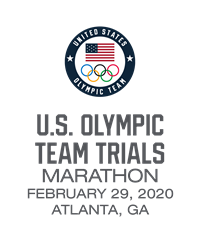RRW: Seven-Hundred Strong, Atlanta Is the People’s Trials
By David Monti, @d9monti
(c) 2020 Race Results Weekly, all rights reserved
ATLANTA (27-Feb) — They come from 45 of the 50 states. They range in age from 16 to 48. They went to Ivy League colleges, public universities, and no college at all. There’s an investment banker, a physician’s assistant student, a software product marketer, a vice-president at an investment management company, and even a senior policy advisor for a United States senator.
But most importantly, they are runners. They are men and women, nearly 700 strong in all, who are America’s best marathoners and they have qualified to compete on Saturday here in what is a uniquely-American tradition: The U.S. Olympic Team Trials Marathon. The race –held every four years since 1976 for men and 1984 for women– is the only completely binding, cutthroat trials marathon in the world which is used to pick an Olympic team. Just the top-3 men and women here on Saturday will be able to represent Team USA in the marathon in Tokyo; the other 99% will go home only with Olympic dreams.
But to view these Trials only through the team-qualifying lens is to miss the point of such a majestic gathering of athletes. Only about ten percent of the field are professional runners with team-making aspirations, while the rest are here to see where they stack up as elite runners in a country of 328 million people. They are running for validation and personal satisfaction. And thanks to relatively gentle qualifying standards –2:45:00 for women and 2:19:00 for men– and advances in training methods, nutrition and even running shoes, these are a far more democratic trials than those which will be held on the track in June in Eugene, Ore., to pick the rest of the Olympic track and field team.
These are the people’s trials.
“The marathon trials are a different beast on their own because you’ve got hundreds of people contending for just three spots,” said Kellyn Taylor, a professional runner who represents the Hoka Northern Arizona Elite team who finished sixth at these Trials four years ago. “You know, there’s 500+ women in the elite field, where in the track there’s 24, tops.” She continued: “I think the atmosphere is different.”
To put those qualifying standards in perspective, the 2:45:00 time the women had to achieve to be here in Atlanta is equivalent to a 35:21.00 10,000m time, using a common conversion formula invented by the late road racing technical expert, Pete Riegel. For the track trials for 10,000m in June, which are limited to just 24 competitors, the qualifying standard is about three minutes faster: 32:25.00. On the men’s side, the 2:19:00 is equivalent to 29:47.00, much softer than the 28:00.00 needed to guarantee a starting place in Eugene.
But road racing has flourished because athletes, organizers, sponsors and cities have all embraced the idea of the big tent. Sure, it’s great to have super-fast people at the front who can win and break records, but it’s just as important to have serious recreational runners behind them, dedicated mid-packers, and even slow plodders at the back. These trials, though surely elite, reflect those values, an important part of what has made marathon running so successful globally.
“The atmosphere, the energy the excitement on the day is just so different,” said Emily Sisson of Team New Balance who will run her first ever marathon trials here after finishing tenth in the 2016 track trials in the 10,000m. “There’s just so much more hype in my mind, especially with so many people who have qualified for this one. I think 700 people qualified. Think of what their families and friends have invested in this race? I’ve been hearing non-stop about this for three months. I think the excitement is building and building.”
But how big is too big? The 2016 Trials, which were held in Los Angeles, had 457 qualifiers and organizers strained to provide each athlete with the kind of attention an elite runner normally receives, including eight personal drinks on the course. Here in Atlanta, the strain on the local organizing committee, the Atlanta Track Club (ATC), is far greater with an over 50% increase in the number of athletes. Moreover, the ATC pledged to fund the travel and lodging expenses for every qualifier when they made their bid, not just the far smaller group of “A” qualifiers who reached the tougher qualifying standards of 2:37:00 for women and 2:15:00 (that is what was done at all previous Trials). These are, by far, the most expensive Trials ever, but for the ATC it’s worth it. Supporting the sport of running is their core mission.
“As we envisioned this weekend two years ago, we took the road less traveled,” Atlanta Track Club executive director Rich Kenah told the media here today. “We wanted to create a weekend that was one hundred percent athlete-focused.”
For Taylor, who finished fourth in the 10,000m in the track trials in 2016 (just one place out of making the Olympic team) having the big field makes these trials even more special. Although she’ll be completely focused on her own race on Saturday, she said that having hundreds of motivated and competitive women behind her means something.
“I think that it’s amazing that a lot of the people who are here for this race, like this is their Olympics,” Taylor observed. “You know, that’s really special. You want them to have a great experience, and celebrate all of their hard work.”



